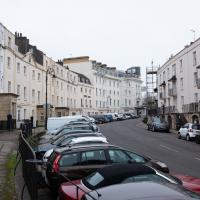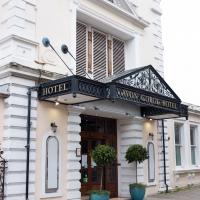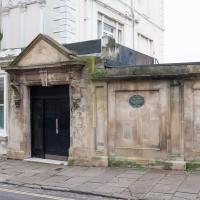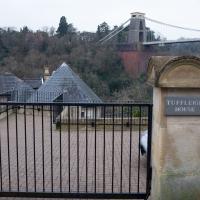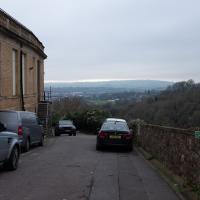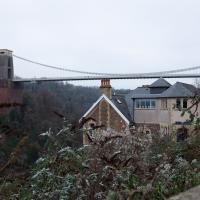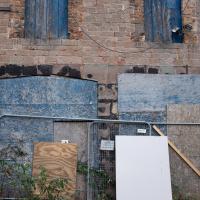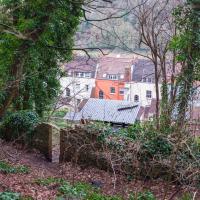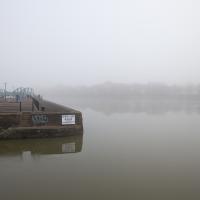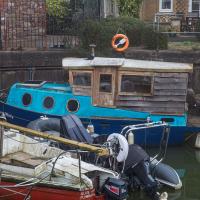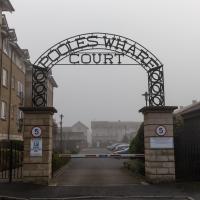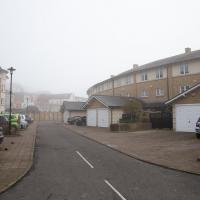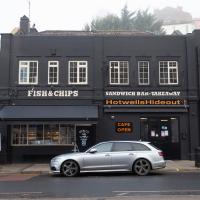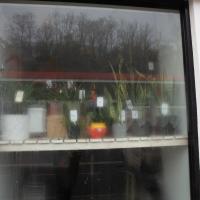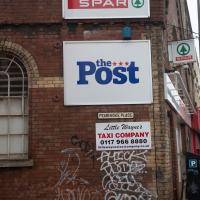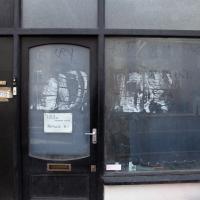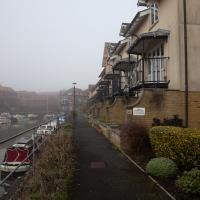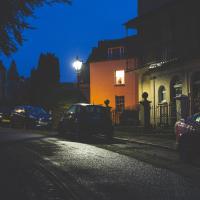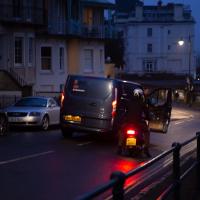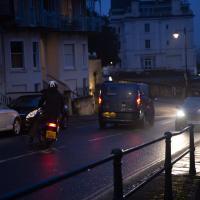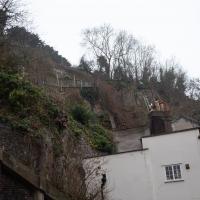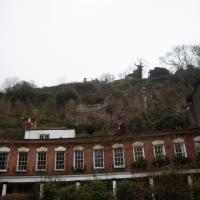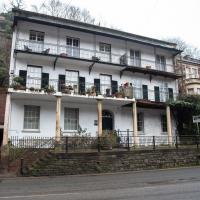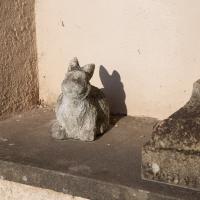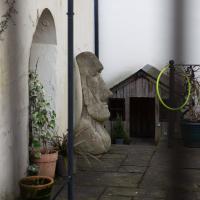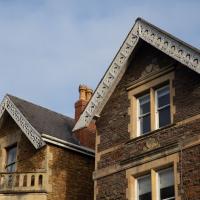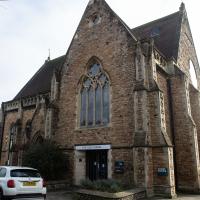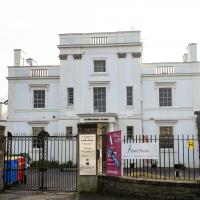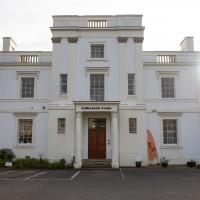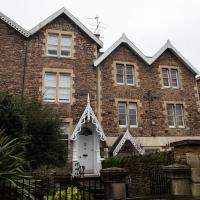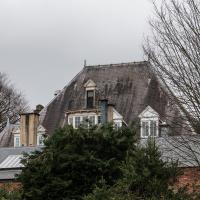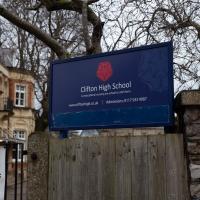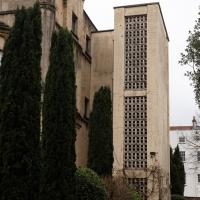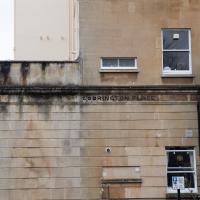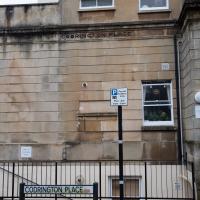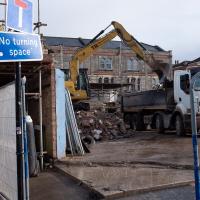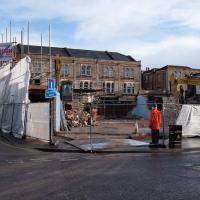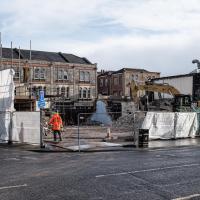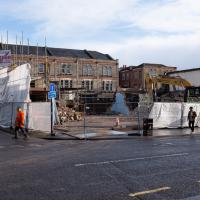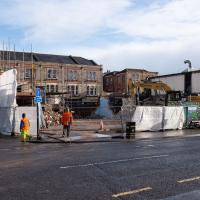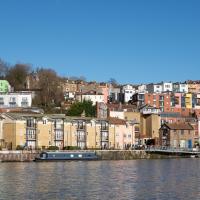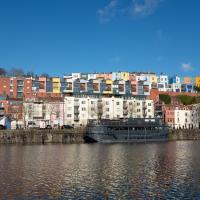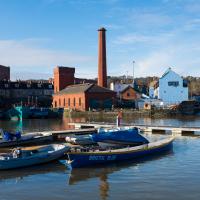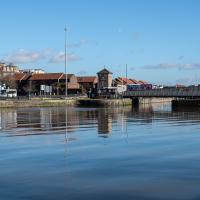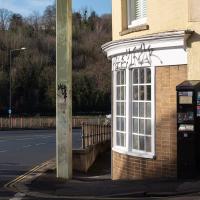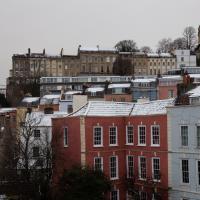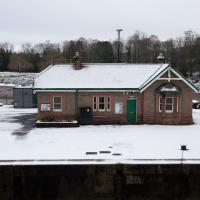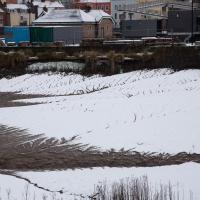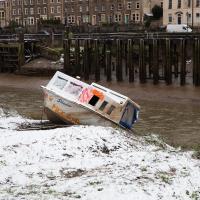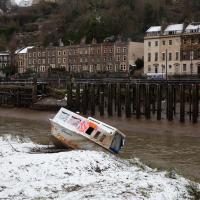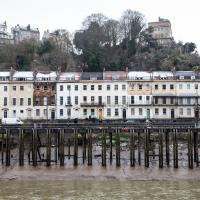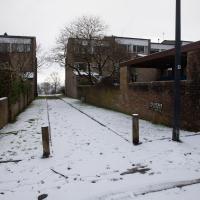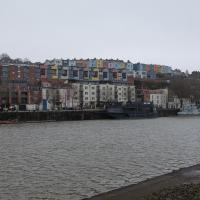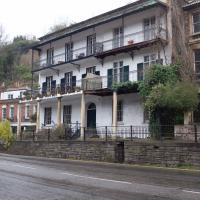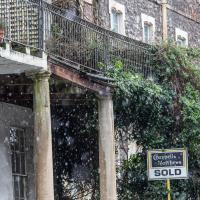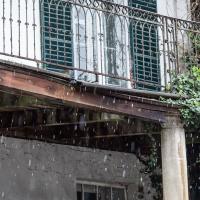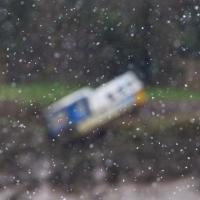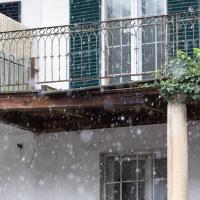Tagged: window
Prince's Lane
06 Jan 2021
The International Grotto Directory website says:
Prince’s Lane might have been one of the original ancient tracks from Hotwells to Clifton, in the Avon Gorge. The site later formed part of Rownham Woods which comprised some thirteen acres. By the end of the 18th century and the early 19th century, the Society of Merchant Venturers granted to Samuel Powell a building lease, for The Colonnade (1786), St. Vincent’s Parade (1790), Prince’s Buildings (1796), and Rock House. Rock House is generally considered to be the oldest surviving building associated with the Hotwell (see Chapter 20). John Power conveyed part of the woods to William Watts for the construction of Windsor Terrace (1790-1808).
The above development of the Avon Gorge cleared Rownham Woods, and created a triangle of land on the north side of the gorge, that became enclosed as a result, by Mansion Houses, whose garden walls all entered on to Prince’s Lane. The Lane started at the bottom of the gorge, at the base rock of Windsor Terrace, and came out half way up Sion Hill. It is clearly shown as a public footpath, dotted with trees, in Ashmead’s map of 1828. Some of the gardens were quite steep in parts and therefore, had to be terraced, because of the gradient of the gorge.
I've passed Prince's Lane literally thousands of times in my life, every time I've walked past the Avon Gorge Hotel, which itself started (in 1898) as the Grand Clifton Spa and Hydropathic Institution and pumped water up from the Hot Well for its hydropathic treatments. I've never actually ventured down it until today, or at least nothing like as far down it as I did this afternoon—I may have poked my head around the back of the hotel to see the original pump rooms at some point in the past.
This was a great wander, though it does very much feel like a private road, and frankly I may have been pushing my luck a bit by winding my way between the astoundingly big back gardens of the houses of some presumably very wealthy Cliftonites, but I felt vaguely justified in exploring the history of one of the oldest footpaths in my part of Bristol...
Or the first sight of them in the distance, anyway. The terrace on the left is Prince's Buildings; we'll be walking being their gardens in a bit...
This building is 1894, but commemorates the original Hot Well House down in actual Hotwells, built in 1694.
I had a quick look, and apparently this grand house with an amazing view is split into flats, with a two-bedroom example going for somewhere in the region of three quarters of a million pounds. Clifton, eh?
A Little Local Wander
07 Jan 2021
Which included a literal "local", the Pump House, to try out their shop/deli/cafe. A flat white, some apples and a New York Deli toastie. Eleven quid, mind, but the Pump House was never a cheap pub...
I enjoyed the fog, and wandering down a few more out-of-the-way back alleys and what-have-you on the Hotwell Road.
I'm thinking of getting up early and going for a morning walk tomorrow, weather-depending, but at the moment my motivation to do things like this seems to be much strong in the evenings when I'm just thinking about it rather than in the morning when I actually have to do it. But it's going to be cold, and low tide is quite early, so there's always a chance of getting some footage of the hot well actually being visibly hot; you never know...
Is "knts" really a helpful abbreviation for "knots"? It's not like there wasn't room for the "o"...
It's a private estate, but I figured nobody would object too much if I wandered straight through. I don't push my way into private areas too much on these walks—my intention in the first place was to only walk down public roads—but sometimes my curiosity about a place I've walked past for decades but never set foot on gets the better of me.
It helps, I'm sure, that I'm white, approaching middle age and have a vaguely RP accent. Plus I do my best to look as un-furtive as possible and only wander through private areas in broad daylight and carrying a big obvious camera, which might be helping rather than hindering. In all the years I've been walking around places and poking my nose in I've never been asked to leave anywhere, anyway, so I've been taking that as a sign that my hopefully-repectful approach is working.
I liked the slightly flying-saucer curve of this bit of Poole's Wharf. I like the Lloyds building on Canon's March, too, which is pleasingly circular.
I understand that the man who first wanted to open this as a fish & chip shop suffered a heart attack not long before the planned opening. That was a couple of years back. Hopefully he recovered and is now running the place, but either way, it's nice to have a fish shop in the area again. The owner of the combined Chinese/Fish & Chip shop closer to me up the road retired a few years ago, and I've been missing it.
I think this is the place that used to sell hot tubs; it's been quite a few things over the years. Now, apparently, they sell house plants. Nice mother-in-law's tongue.
And, inevitably, a load of tagging. The Spar is a pretty awful example of the kind of chain shop that's not good at the best of times. It survives, I imagine, because there aren't any other shops.
I think you're also discouraged from walking down the other side, on the Rownham Mead estate, but I've been doing that for years. The gates and the fact that it leads somewhere less useful are what generally stop me here, but the whole Poole's Wharf estate seems generally more wary of strangers.
Morning Walk
08 Jan 2021
Tempted by a hopeful repeat of yesterday's weather, I got up early this morning and went for a short walk up into Clifton Village, around Observatory Hill, back down the Zig Zag and home. Instead of beautiful and mysterious fog and crisp freezing brightness I got some murk and slight dampness which included witnessing a road-raging van driver and finding that it still wasn't cold enough for the hot well to be even gently steaming when I got down there. I've still never seen it steaming, but I've been told it does, on colder days.
The van driver, who'd nearly driven into the side of the motorcyclist while doing a three-point turn just this side of the blind bend at the top of Sion Hill, became increasingly aggressive in the ensuing "discussion", including pointedly shouting that it didn't matter who was right, because he was in a van and the other man was on a bike, "so who'd be working afterwards?" in the event of a crash.
I'd stopped to make sure nothing terrible happened; when he got out of his van, walked right up to the motorcyclist and started shouting in his face, I started walking back towards them, taking the occasional photograph in the hopes that realising his actions were being witnessed and documented might make him think twice about turning physically violent. I don't know whether it helped, whether it was the car coming up behind us, or something else that made him get back in the van. Whatever, he got back in and screamed off far too quickly down the hill.
As you can tell, I didn't have time to change the camera settings. Getting the monopod back unfolded was also not much of an option :)
The way the left-hand side looks a lot more together than the right-hand side may be explained by the very first part of the listing:
Rock House, now divided into 2. c1800. Render with limestone dressings, roof not visible. Double-depth plan. Late Georgian style. 3 storeys and basement; 5-window range. A symmetrical front has pilaster strips to a moulded coping, a wide basement area with Pennant-stepped bridge to an elliptical-arched doorway with metal batswing fanlight and 2-leaf 12-panel door with fluted lower panels. In front of the basement area is a later colonnade of 6 slim Tuscan columns, square to each end, to a deep first-floor balcony, and a shallow, tented second-floor balcony on cast-iron brackets with flat stanchions, both with pointed-arched wrought-iron railings with quatrefoils; 8/8-pane ground-floor sashes, French windows above, and plate-glass basement sashes.
However, I've found several references that suggest that even Historic England's estimate of the date of the property is wrong. I just found one in a planning document, part of an objection to a planning application related to Prince's Lane by the Cliftonwood and Hotwells Improvement Society:
Rock House (412 Hotwell Rd) is shown in an early engraving by William Halfpenny in 1731 so is much older than any of the neighbouring buildings and is the sole survivor of the original Hotwell Spa. It is incorrect to say it dates from 1800, and the planners have been told this.
I haven't, sadly, tracked down the engraving itself.
Mirror Maze
10 Jan 2021
Went for a wander with my friend Lisa—the current lockdown rules seem to be that one local walk for exercise per day with a maximum of one person not in one's "bubble" is fine—up to the University of Bristol area right at the edge of my one-mile perimeter to see the Jeppe Hein Mirror Maze, among other things. On the way we mused about Merchant Venturers, the slave and tobacco trades, and dating in the time of Covid.
It may say "Reflections House", but in its listing it's called "The White House". Charles Dyer, 1850.
I imagine it would look a lot nicer if it weren't backlit. Maybe I'll try taking another snap of it at a different time of day...
One of the roads I used to walk down regularly on my way home from a job at the top of Whiteladies Road. I used to enjoy cutting through here and crossing through the closed-to-cars bit just around from the Lido at the far end.
Northern Clifton
16 Jan 2021
A raggedy wander with my friend Lisa, picking up a few stray streets and venturing only briefly onto Whiteladies Road, where it was too damn busy, given the current pandemic. We retreated fairly quickly. Found a couple of interesting back alleys, and got a very pointed "can I help you?" from a man who was working in his garage in one of the rather run-down garage areas behind some posh houses, and clearly didn't want us just wandering around there.
Here's an interesting sinkhole-related snippet:
"In September 2007, Peter Insole of Bristol City Council visited no.52 Clifton Park Road, Clifton to investigate the report of a mine shaft in the rear garden that had been exposed during gardening work. In the southwestern corner of the garden a rough rock cut shaft approximately 1m in diameter was observed. It was not possible to fully survey the feature for health and safety reasons, but it appeared to be excavated through sandstone or Dolomitic Conglomerate and was at least 2m deep. The shaft opened out into tunnels or chambers beneath the rear gardens of the Canynge Square properties. It is possible that this feature was associated with a previously observed cellar or chamber beneath the rear garden of 22 Canynge Square, although there are no known cartographic or documentary records for mining activity in the area."
Oddly, this is a little crescent that two-thirds Coddrington Place and one-third Belgrave Place, it seems
Birthday Coffee
21 Jan 2021
A quick jaunt to Clifton Village to grab a birthday coffee and cake (courgette, lime & pistachio, thanks for asking) from Twelve, and rubberneck at the demolition of the block that used to house the WH Smith, among other things. I remember the Havana Cafe, Mail Boxes Etc (for those who wanted a Clifton postcode without living there?) and others.
Tearing down the old eyesore that used to be a collection of random offices, a cafe, and WH Smith.
Coffee and Graff
22 Jan 2021
Took myself around the harbour to Imagine That's horsebox cafe and treated myself to a flat white and a sourdough cheese toastie. On the way there and back I encountered some local flooding and various bit of graffiti, from some ugly tagging on someone's front windows to a large new piece being added to Cumberland Piazza in the ongoing attempts to cheer the place up.
Can't be pleasant to have your house tagged. I don't imagine that anyone living in a house right on an arterial road whose front door opens virtually onto a pllar supporting one of the ugliest street signs of the Cumberland Basin is exactly swimming in money or time to re-paint their frontage, either.
Snowy Leigh Wander
24 Jan 2021
I started this wander with my "support bubble" Sarah and Vik, after Sarah texted me to say "SNOW!" We parted ways on the towpath and I headed up into the bit of Leigh Woods that's not actually the woods—the village-like part in between Leigh Woods and Ashton Court, where I'd noticed on a map a church I'd not seen before. I found St Mary the Virgin and quite a few other things I'd never experienced, despite having walked nearby them many, many times over many years, including a castellated Victorian water tower that's been turned into a house...
Another Lunchtime, Another Quick Coffee Trip
28 Jan 2021
With very little photography, and no new streets. Still, I did manage to buy milk at the "Simple Cow" vending machine—and "simple" is very definitely false advertising; it took me bloody ages to work out how to use the thing—and snap the new ACER/SEPR piece down in Cumberland Piazza.
This was just a little car park, presumably for the house behind? Probably going to be turned into half a dozed bijou flats, or something...
Unexpected Snow
31 Jan 2021
I just nipped out to post a blood test (not Covid-related) and check that my car was okay, because I've not driven it for weeks. I was just going to walk up to Clifton Village, but I spotted the opportunity to re-park the car on my street rather than up the hill around the corner where it was, so instead I got in, intending just to move a hundred metres, but it turned over slowly before it started, and then warned me that the battery was very low and I should go for a long drive to recharge it.
So, I did my best, zipping up the A4018 to the motorway junction and back again, dropping off my blood at a postbox along the way, and while I did that, it started snowing. I noticed it was low tide, too, so when I got back home I headed back out again, this time on foot and with a camera so I could see if I could find any evidence of the Hot Well steaming.
I saw not a single sign of the Hot Well steaming, but it was quite a nice quick outing and I enjoyed my brief walk in the snow. Iike Hinton Lane, too, and while it's all old ground I was re-treading, I did at least get a picture or two with a bit of snow and some of the cold winter atmosphere of the trip, I think.
